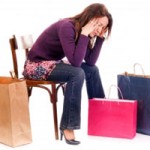We at Postconsumers think that our entire society is addicted to consumerism, although some lucky people – postconsumers! – have moved beyond it and find the satisfaction of enough each day. Our work is based on and produced in cooperation with the Semel Institute for Neuroscience and Human Behavior at UCLA, especially Director Peter C. Whybrow MD’s book, “American Mania: When More Is Not Enough.” Our 30-minute web course below is a good way to deal with American mania and overall addictive consumerism, but the rest of this article relates to the particular mental illness of oniomania.
First termed around a century ago, the term “Oniomania” is used to describe the specific mental illness of a shopping addiction (aka compulsive shopping, compulsive buying, or shopaholism). While we might think of “shopaholics” as a recent phenomenon, being clinically addicted to shopping has been troublesome for a very long time. As long as there is advertising, there will always be people who fall prey to it more than others, and with any disorder, their buying habits can go to extremes.
Knowing The Difference Between Cultural Shopping And Oniomania
When it comes to figuring out what the difference is between taking “normal” shopping trips and full-blown addiction, it helps to take a look at a person’s psychological state and see where their head is. Most of us go to the store for our usual buys like groceries and other household items. But those who are stressed out may feel the impulse to go to many kinds of stores for clothes, or shoes, or just about anything else to try to relieve that stress, even when they know it could lead down a bad road. Of course, like other kinds of addictions, compulsive shopping can destroy people’s finances, leading to major damage in their relationships. Many of the items that are bought on compulsive shopping trips are likely to go unused while they start to crave their next shopping trip.
Tips For Dealing With Oniomania
If you find yourself or a loved one showing the signs of an impulsive shopping addiction, there are ways to address it. Of course, there is still controversy about the psychology of shopping addiction, but a range of therapies from self-help books to cognitive-behavioral therapy and even financial counseling have all been shown to help (with the caveat that not all therapies have been well-researched or formally proven). If you realize that you’re spending the money to escape emotional states and know that you can afford therapy, seeing a psychologist may be your best bet to deal with the issues that might be plaguing you. Once you can target where this particular shopping addiction is coming from, creating a budget can remind you where your money is going. If you have a support system, ask them to go with you on shopping trips so that you’re buying what you need instead of buying just to buy.
Have you known anyone with an extreme shopping addiction? Like us on Facebook and tell us!
Need more assistance in learning to let go of the consumer media’s impact on your life, take control of your finances and find the satisfaction of enough for today? The Get Satisfied Interactive Handbook is a 30-minute web course that walks you through a series of specific questions and then presents a personalized how-to plan for becoming a postconsumer. Launch your evaluation for free right now.




